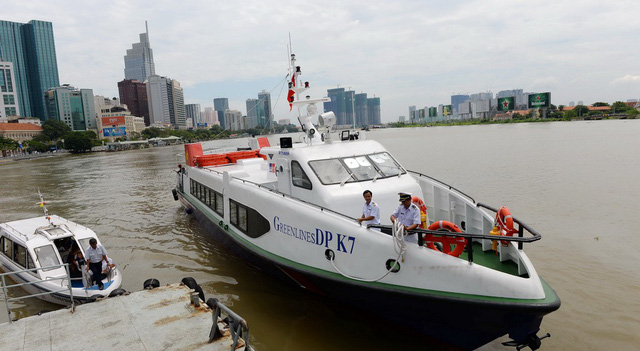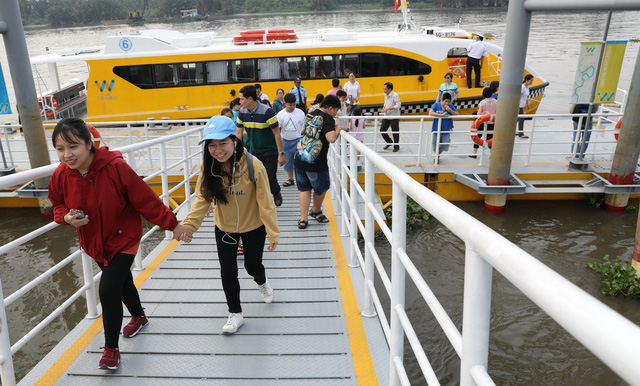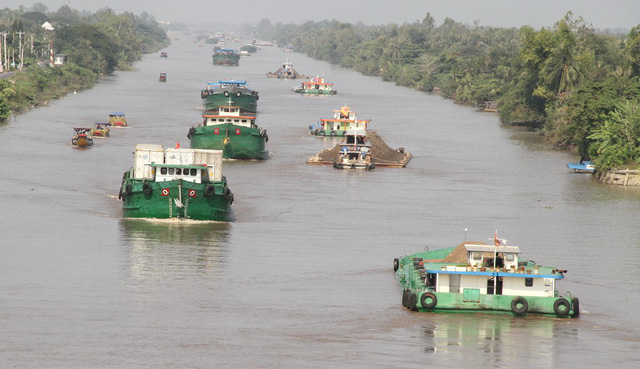As Ho Chi Minh City continues to grapple with traffic congestion on roads, the full potential of its waterways has yet to be tapped as an alternative.
The southern hub is entitled to not only one but two major rivers, Saigon and Dong Nai, which together form an extensive network of tributaries and canals measuring close to 1,000 kilometers in total length.
The vast network of waterways connects the city’s inner areas as well as Ho Chi Minh City and neighboring provinces in the Southeastern and Mekong Delta Regions.
However, aquatic transport is barely used by local residents for their commute, with only around one million people traveling by river on a yearly average, according to Ngo Dinh Quang, head of inland waterway ports of the municipal Department of Transport.
“The number is very humble if you put it into perspective alongside the 600 million passengers who travel by bus in the city in one year,” Quang said.
 |
| A high-speed passenger boat plying between Ho Chi Minh City and Vung Tau docks at a port in Ho Chi Minh City. Photo: Tuoi Tre |
Underdeveloped infrastructure
Lieu Thi My Hanh, director of a Ho Chi Minh City-based company that offers water transport services, said her firm’s fleet of 15 high-speed boats had not been able to operate to their maximum capacity due to underdeveloped aquatic infrastructure.
Current river ports and stations are poorly equipped, lacking even basic facilities like restrooms and roofs, while business owners are made to pay high fees to use such services, Hanh pointed out.
Despite being Vietnam’s largest economic hub, Ho Chi Minh City still lacks a proper passenger port as tourists arriving on even the most luxurious cruise ships are forced to disembark at ports meant for cargo ships.
Only recently has the local administration approved a plan to build an 18-hectare passenger port in Nha Be District to serve as the transit point for travelers to Ho Chi Minh City, where river buses and high-speed boats will be available for tourists to continue their journey into the city center or to neighboring provinces.
 |
| Passengers disembark from a river bus in Ho Chi Minh City. Photo: Tuoi Tre |
New horizons
According to the municipal transport department, southern Vung Tau City and Tien Giang Province are currently the only two destinations for regular passenger boats from Ho Chi Minh City.
To fully unleash the city’s position as the locomotive for the southern key economic zone – which includes the provinces of Dong Nai, Binh Duong, Binh Phuoc, Tay Ninh, Long An, Tien Giang and Ba Ria-Vung Tau – a developed system of waterway transport is crucial, the department asserted.
The city’s vision until 2020 is to upgrade its ports and improve their connectivity with those in southern Can Tho City, which will serve as transit points for cargos and passengers between the regions.
By the year 2030, the city will have looked to connect its waterway ports and stations with road and railway ones to establish an interconnected network of transport.
A plan to launch seven tourist routes by river among Ho Chi Minh City and other southern provinces is also in place until 2020, offering travelers more touring options during their visit to the region.
Since November 25, a river bus route connecting Bach Dang Port in District 1 with Linh Dong Ward in Thu Duc District has also been put to use to generally positive feedback from passengers.
“It’s a bit late for Ho Chi Minh City now to shift its focus to the development of water transport,” said Dr. Nguyen Xuan Thuy, a transportation expert.
“But as the saying goes, better late than never.”
Like us on Facebook or follow us on Twitter to get the latest news about Vietnam!






















































